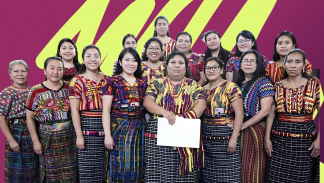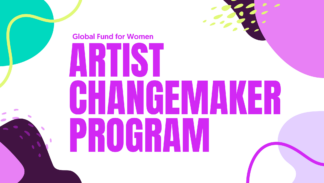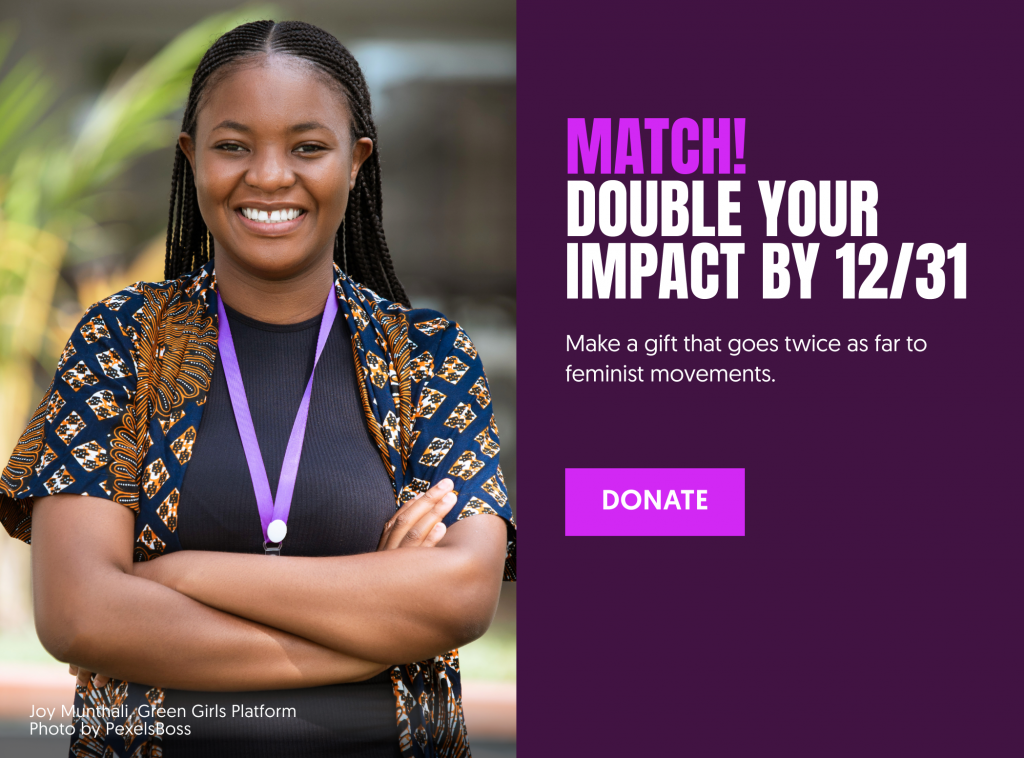Visiting Nepal one year after the earthquake: A reflection
Two Global Fund for Women team members—Margaret Youngs, Program Officer for Asia and the Pacific, and Eva Kolodner, Regional Director, East—traveled to Nepal in the middle of April to visit with Global Fund for Women’s grantee partners and see their work first-hand. This is their reflection from their trip on what life in Nepal is like for women one year after the earthquake.
Based on Nepal’s lunar calendar, April 13th is the start of a new year, and we were able to add our wishes for peace and prosperity as we observed the festivities that day in the old city square of Bhaktapur—wishes that remain badly needed even now as people continue to heal from the trauma and rebuild their lives after the earthquake that rocked the country one year ago.
From the moment we stepped off the plane in Nepal, our trip was a whirlwind. Somehow in less than 12 hours we joined our sisters from Tewa and Nagarik Aawaz, two Global Fund for Women grantee partners, on a three-hour road trip up the steep hillsides to one of the most severely earthquake-affected districts, Sindhupalchok. There, we met with amazing young women who have been volunteering in earthquake-hit communities for the past year, helping to conduct needs assessments, and teaching other women and girls about their rights.
On our third day, we met with a group of 15 women who belong to a long-running local women’s group run by Women’s Rehabilitation Center (known as WOREC in Nepal). Already strained by climate change and water availability to make their farms fertile enough to either raise or sell enough food to support their families, after the earthquake, these women saw an opportunity for sustainable change. The women in the group requested that WOREC hire a trainer to teach embroidery skills, as they had identified a viable local market for intricately beaded textiles used in wedding finery, and knew this could become a well-compensated profession. Alongside this embroidery training (pictured above), a long-time community organizer from WOREC who coordinates the group provides workshops about gender-based violence, women’s economic empowerment and marketing for their products. One woman proudly told us how she had already sold one small piece of her embroidery work for 300 Nepali Rupees—three times the amount she would be able to make in a day from selling vegetables in the market. The confidence and pride we heard in their voices as they talked about their new pursuit—and the independence it gave them—was incredible.
By the end of our trip, we had visited remote parts of Kathmandu and small villages nestled into the hillsides of the valley, and seen first-hand the incredible work of Global Fund for Women’s grantee partners to rebuild and empower women in the aftermath of the earthquake. Time and time again, we heard and saw how these grantees, and the women they serve, transformed the devastating situation into opportunities for lasting change.
Talking with women about their earthquake experiences is still very emotional, even one year later. Several shed tears as they recalled the days and months following the quake—many had lost their homes, their possessions including their livestock, and their livelihoods—and over the course of our trip, we also met several women who lost children, husbands, relatives and neighbors.
“I lost my daughter in the earthquake. She was 22 years old, and doing her bachelor’s degree. At the time of the quake, she was working in a big building in the city that collapsed,” explained one woman we met named Kanchhi, who is part of a group for single women and widows created by Women for Human Rights in Machchhegau. “I was in no condition to talk to anyone for a few months. Women for Human Rights built a shelter for me to live in and helped me to get my ID card.”
Beyond the clear evidence of the remaining destruction and damage from the earthquake in every place we visited, what really struck us was the extra challenge posed by the blockade of imports after the passage of Nepal’s constitution in September. Because Nepal is a landlocked country, it depends entirely on India for fuel and most of its food and medicine, but the largest checkpoint in the border town of Birgunj was blocked by protesters from the Madhesi communities demanding greater representation in the constitution for five months. The blockade, now lifted despite continuing protests that continue to delay goods crossing the border, meant that there were many supplies and necessities that people in Nepal could not access. There were shortages in medicine, food, agricultural products, and fuel as a result.
Many women we met used to be able to buy cooking fuel in the market but, during the blockade, had to walk to gather firewood. This poses significant risks for women—in terms of becoming more exposed to sexual violence and harassment, and the risk of physical injury from the effort of carrying firewood long distances, not to mention the strain on natural resources as a result. It’s stunning that the world was largely silent on the blockade and its implications for Nepali women and men working to rebuild their lives, homes, and communities after the enormous devastation of the earthquake.
Yet, despite the dual challenges of the earthquake and the blockade presented during the past year, the women we met with throughout our time in Nepal—the founders and staff of our grantee partner organizations as well as the women and girls that they work with—are extremely bold and resilient and have worked hard to put the trauma behind them and embrace a more hopeful vision of the future.

Just one example of too many to count: on our first day in Nepal, we met a woman named Sita in Saithok, a village in Sindhulpachok district nestled on the side of steep hills where women are in the process of rebuilding the 47 homes there that had been completely destroyed in the earthquake. Sita shared that at the time the earthquake hit, her husband had just migrated to Malaysia for work (as many men in this area of Nepal do because of the lack of local employment opportunities). She was with her then one-year old daughter in her house, which collapsed around them. Her seven-year-old son was on the terrace and jumped off when the house began shaking. Thankfully none of them were hurt, but their house was flattened and completely destroyed. With support from Global Fund for Women grantee partner Tewa, the debris of Sita’s home was cleared and will be rebuilt through the local women’s construction committee—a group of women who are leading and executing all of the rebuilding efforts in Sita’s village. During our visit, we could see that the new structure remains just an open space with one wall. The process of rebuilding, for women like Sita, remains too slow.
Sita is also part of a new community center in the village, built by Tewa and Nagarik Aawaz, where women gather to discuss their problems and work together on solutions. Since starting to attend, Sita has learned how to write the letters of the alphabet beyond her own name with Tewa’s help. She shared that her greatest hopes are to rebuild her house and to make sure her children, particularly her young daughter, get to go to school since she did not. Sita has a plan to send her daughter to preschool—there is one a 15-minute walk from their home that she will take her to—and her now-eight-year-old son is already staying with Sita’s mother so that he can attend school, where he is now in 2nd grade.
We met incredibly bold women like Sita throughout our time in Nepal. We were struck by their determination to build a better life not only for themselves, but for their children—especially their daughters. Like Sita, many women expressed a desire to ensure that their daughters go to school and continue their education as long as they’d like, and to ensure that their daughters understand their rights and are empowered to be independent. It’s clear that this acute knowledge and understanding of women’s human rights comes from the work of grassroots women’s groups who are educating women and girls and empowering them to claim their rights. It was amazing to see the extraordinary importance of these workshops and programs come to life through women like Sita and many others in Nepal.

We met Laxmi during a field visit with Global Fund for Women grantee partner LOOM in the most remote part of Kavre district, a completely isolated village called Anekot. Laxmi has long been a participant, along with her three sisters-in-law, in a local mother’s group, which after the quake received “women’s aid kits” from LOOM and was part of their health training program. This combination of providing immediate necessities (like sanitary napkins and a change of clothes not provided by other humanitarian aid agencies working in this isolated area), alongside access to critical information (on maternal and newborn healthcare, trainings on women’s human rights, political participation, and ending gender-based violence), illustrates the kind of comprehensive, rights-based approach of Global Fund for Women grantees take in times of crisis.
When we asked if anyone had questions for us, and how we could better share their stories to drive more resources and support to them, Laxmi spoke up: “We don’t need money. We appreciate this training because it helped us see what was in ourselves—it gave us more knowledge and confidence. That is the value. Women being able to understand themselves, speak for themselves, raise their voices—that is what we gain from LOOM.” Her story perfectly sums up what sets apart the work of our grantees in disaster recovery—essential support combined with a long-term lens to building equality, rights, and empowerment.
We returned from Nepal inspired and in awe of the strength and power of women to keep on with their lives in the midst of chaos. From remote villages to crowded city centers, and amid the destruction, rubble, and temporary shelters—it was astounding to see what grassroots women’s groups have accomplished in just a year, especially realizing the power within themselves to change their lives rather than simply accepting hardships as their lot in life. It makes clear why investing in grassroots women’s groups with deep roots in their communities is so essential in times of crises, conflict, and natural disasters. Their work makes a huge difference not only in immediate relief and recovery, but in terms of long-term rebuilding and rehabilitation where restoring people’s hopes for a better future is as important as rebuilding the homes and livelihoods that were lost.
On our second day in Nepal, Nirmala Shrestha, the incredible founder of the community-based organization Women’s Awareness Group (supported by Global Fund for Women grantee Beyond Beijing Committee), said something that stuck with us throughout the trip and will remain as we continue to think about our experience and how to continue supporting the incredible women in Nepal:
“I was one of ten children, and having polio set me apart. Because of my disability, my family knew I could not make a livelihood in farming, like the rest of my family, so they prioritized my education. In this way, polio was a crisis that gave me an opportunity to develop strength. The earthquake was the same for us—it was a crisis that provided an important opportunity to empower women.”
[All photos by Eva Kolodner.]
Send a message of support to women in Nepal
One year later, your words of solidarity matter. Write a message of support to show women survivors of the earthquake that you care and stand with them. Recognize their critical work and thank them for their courage.



